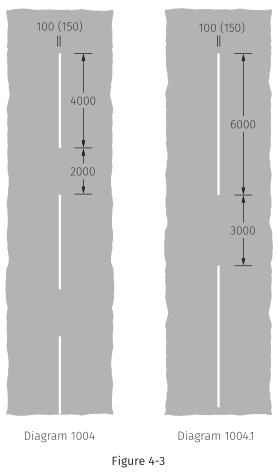4.10 On single carriageway roads with more than two lanes, the centre line should normally be of a greater width than the lane lines. This is particularly important when the warning module is used for both, making it more difficult to determine which line divides the opposing traffic streams.
4.11 On 70 mph dual carriageway all-purpose roads and on motorways, the wider (150mm) marking should be used as this increases its visibility distance. It is also likely to be of benefit on concrete roads, even with a lower speed limit, helping to compensate for the reduced contrast.
WARNING LINES
4.12 Warning lines are detailed in figure 4-3 and table 4-3. They are used:
(i) as centre lines at bends and crests, and on multi-lane roads (see paras 4.16 to 4.18),
(ii) as centre lines where it is necessary to highlight the presence of a road junction, central refuge or other hazard (see paras 4.19 to 4.23),
(iii) approaching or through junctions (see para 4.24 and sections 7, 8, 9 and 10),
(iv) to mark the boundary of advisory cycle lanes (see paras 16.9 and 16.10), and
(v) over road humps (see para 21.10).
4.13 Warning lines are always single; they must never be used as part of a double line installation, and must not be formed of raised rib markings (see paras 4.39 to 4.48).
4.14 Two patterns of warning line are prescribed,each having alternative widths of 100 or 150 mm. The wider line is visible at a greater distance, and should be used where this might be beneficial, e.g. at particularly hazardous sites (see also para 4.10). The two standard modules are 6 metres and 9 metres in length (the combination of one mark and one gap) depending on the speed limit. Table 4-3 sets out appropriate arrangements for various road layouts and speed limits.
fig4.3

4.15 Overuse of the marking should be avoided. Its use where it is not justified will devalue its effect. Particular care should be taken in urban areas where there might be a temptation to use it extensively.
4.16 Warning lines are used in place of centre lines where forward visibility is less than the warning line visibility distance W indicated in table 4-4. This is based on the visibility necessary for safe overtaking on a two-way carriageway (see para 5.22 for the definition of visibility distance). For intermediate speeds, the appropriate visibility distance should be taken as the higher figure between the steps shown, e.g. for an 85th percentile speed of 45 mph, warning lines are justified when visibility is between 120 and 195 m. Where the visibility distance is less than the desirable minimum V, a double white line system should be considered (see section 5).
15
